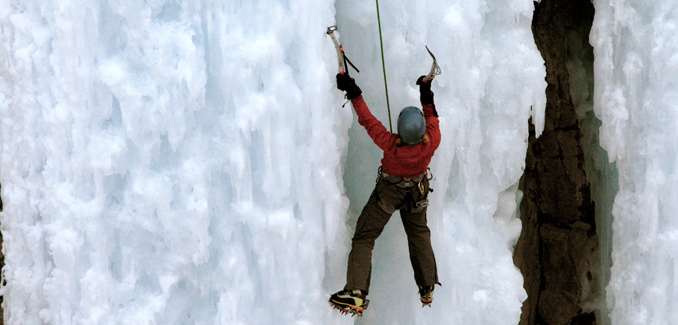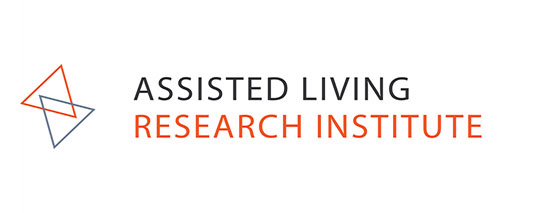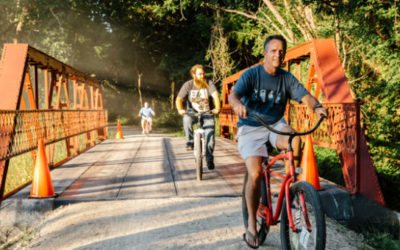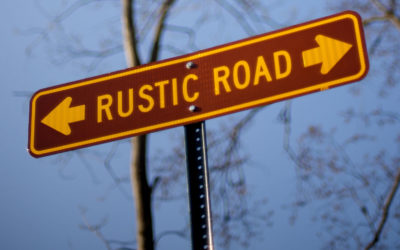How an Icy Manmade Playground Transformed Ouray’s Wintertime Economy
The color of money may be green, but in Ouray, Colorado, fortune has always come painted in primary colors.
Red, for the nearby Red Mountains – iron-rich, glacier-carved remnants of ancient volcanic eruptions – where fabulously rich silver mines were developed in the 1880s, and where the infamous Million Dollar Highway now winds its treacherous way from Ouray to nearby Silverton over Red Mountain Pass.
Yellow, for the millions of dollars’ worth of gold that was mined from other parts of the Ouray mining district, well into the 20th century.
Blue, for the 45.52-carat Hope Diamond that Ouray native daughter Eleanor Walsh bought for herself with her inherited fortune, years after her daddy Thomas Walsh had struck it rich at the Camp Bird Mine in 1896. Blue for the tides of columbine and wild delphinium that bloom up in Yankee Boy Basin in July. Blue for the cold-lipped winters, and for epic powder days under bluebird skies.
And blue, these days, for the slick tongues of ice that slither down into the Uncompahgre Gorge at the legendary Ouray Ice Park, where herds of ice climbers from around the world convene every winter to climb by day, and soak in the local hot springs by night.
The narrow ice-clad canyon echoes with the sound of myriad languages and accents, and countless picks swinging into ice, for up to three-and-a-half magical months each winter. Deep within its depths, you would never guess that the Million Dollar Highway snakes past just over the lip of the canyon, and that the bustling little town of Ouray (pop. 1,033) is just a few minutes’ walk away.
There are other ice parks out there in the world, but the Ouray Ice Park is the first, the largest and best known by far, and has put its namesake community on the map as a world-class ice climbing destination.
The Dawn of Ice Climbing in Ouray
It wasn’t always this way.
Ouray, which was originally called Uncompahgre City for the river that flows through it, was settled around 1875 after gold was discovered at the nearby Mineral Farm claim. Mining, and summer tourism, kept the town going for the next 100 years, through booms and busts, until the last active mine in the area, the Idarado, gave up the ghost in the mid-1970s.
To say that things got quiet in the winter in Ouray after that is an understatement. On a winter’s morning in the late ‘70s or ‘80s, as storm clouds lifted off the ragged ring of peaks that encircle the town, there might not be a single car parked on Main Street, not a sign of life, save a few sets of footprints trailing through fresh-fallen snow, a down-filled duvet of silence gently smothering the town.
But as Ouray’s mining star was setting, another ice-blue star twinkled on the horizon. Southwestern Colorado’s San Juan Mountains, with their sunny days, freezing nights and shamelessly vertical terrain, were becoming a playground for ice climbers.
Telluride had Bridal Veil Falls — at 365 feet, the highest one-stage drop of waterfall ice in Colorado. Ice climbing pioneers Jeff Lowe and Mike Weis claimed its first ascent in 1974, and ABC’s Wide World of Sports broadcast the attempt, much to the horror of the Idarado Mining Company which owned the land (and thus bore the liability if anything went wrong).
But the genie was out of the bottle, and the crazy sport of ice climbing slowly became a thing in little mining towns across the San Juan mountains.
While Silverton was infamous for its high, remote backcountry ice climbs and Telluride beckoned with its sexy Bridal Veil prize, Ouray’s ice climbing reputation grew more from its appealing blend of variety and convenience. Alongside world-class climbs in the mountains around Ouray were less difficult, but nice places to practice – particularly in the Uncompahgre Gorge, just five minutes’ walk from downtown Ouray.
“You didn’t have to hike in two or three hours just to get to the ice,” explained longtime local guide and alpinist Vince Anderson. “That created a draw.”
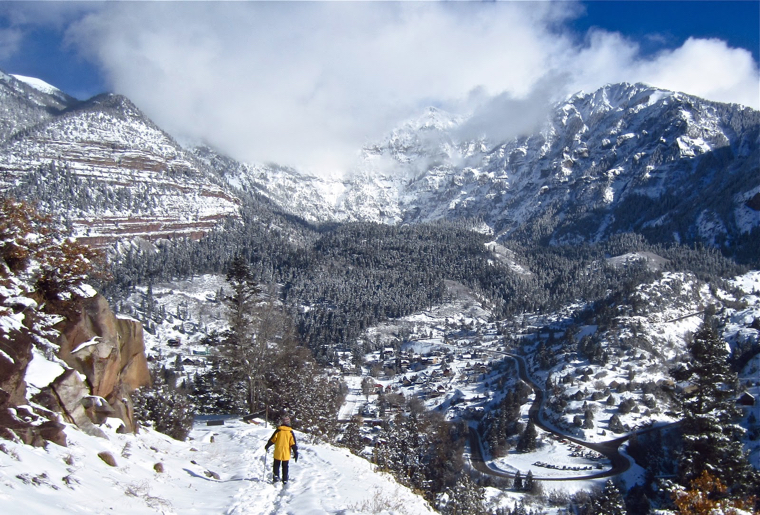
Box Canyon Snowshoe
pc: Mark Johnson
Finding ice was easy. Harder to find in wintertime Ouray in the ‘70s and ‘80s was a hotel that was open. “You would go into the Portal (Ouray’s bar of the day), and somebody would know somebody who would open up a room for the night,” Anderson recalled.
The Silver Nugget was the only restaurant open, “but we were typically cheap climbers and mostly cooked for ourselves,” recalled celebrated mountaineer and former editor of Alpinist magazine Michael Kennedy, who first visited Ouray in 1977 to ice climb with Lowe. “Conveniently, both Duckett’s Market and a nearby liquor store were in operation, so we had all the bases covered.”
A Brilliant, Crazy Idea
Not much had changed when 20-something California windsurfer bum Bill Whitt blew into Ouray over a decade later on May 1,1989. The newcomer was quite the oddity in town.
“It was crazy,” Whitt recalled. “My first house was directly across the street from the school. I had my moving van out there, and I remember at lunch time, there were all these kids out there pinned to the fence. I had a pair of pink Mossimo board shorts on, and I was pulling my wind surfers out of the truck, and these kids, I could hear them saying, ‘Wow, he’s got surf boards.’”
Whitt questioned the wisdom of moving to a place where the kids didn’t even know the difference between a surf board and windsurfer. But it didn’t matter. Soon enough, he’d traded in his wind-surfing gear for backcountry skis, ice tools and crampons.
As far as Whitt knows, he and fellow local Bill McTiernan were just about the only guys climbing ice in Ouray back then. There was so much ice to climb, they made a pact that they wouldn’t start climbing until after Thanksgiving, so they wouldn’t get burned out. “We never ran into anybody,” he said. “People knew the ice was here, but it wasn’t a climbing hub.”
As busy as Whitt was being a climbing bum, he still needed a way to earn a living. So in 1991, Whitt and an attorney named Gary Wild became partners in a local hotel called the Victorian Inn.
Things were plenty busy at the hotel in the summer, but in the winter there was no point in even staying open. “It was a full-on ghost town. You could lay down on Main Street in the middle of January and not get run over,” said Whitt. “It was so slow, people can’t even comprehend what Ouray was like without ice climbing here. Yeah, it was dead.”
So, the story goes, they started the Ouray Ice Park as a way to bring more people to town in the winter months. “We thought if we could just get a handful of guys to come visit – anything’s better than nothing,” Whitt explained. “We thought – ‘Why not?’ It would help our business, and people would be spending money in the town.”
Whitt, McTiernan, and a few other local climbers were already poaching a handful of routes in the Uncompahgre Gorge, on formations that formed from a drippy pipe that fed into an old abandoned city reservoir.
The idea was simply to divert that water to more places in the canyon, to make more ice to climb. But first, they had to solve the access issue. Much of the land skirting the Uncompahgre Gorge belonged to Eric Jacobson, the owner of the Ouray Hydroelectric Plant, whose century-old infrastructure delivered water from another reservoir a mile further up the gorge to a powerhouse in town via a pressure pipeline alongside the Uncompahgre Gorge.
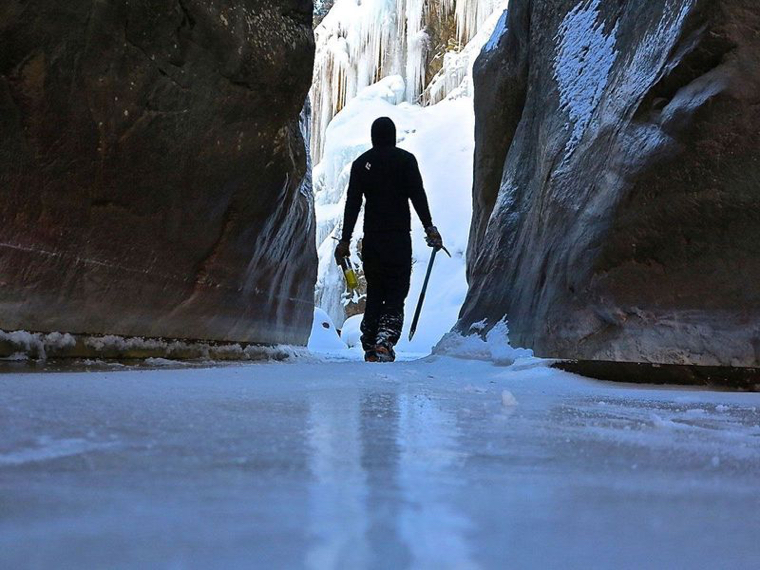
Ice Farming Hero
pc: Dan Chehayl
As luck would have it, the powerhouse was right across the river from the Victorian Inn. As Whitt tells the story, Jacobson and Wild were not crazy about each other. But then one day, “Gary walked over with a six-pack, sat down with Eric, they started drinking beers, and it was like, ‘I love you, man,’ and boom, it was solved. They worked it out. Without that, there would never be an Ice Park.”
Jacobson, an out-of-the-box kind of guy, got fully on board with the concept, even giving Whitt and Wild permission to weld taps onto his pipeline along the lip of the gorge to make more ice. But the water in the penstock came straight out of the acidic, rust-red Uncompahgre River, and formed icicles that were neon orange, not sparkling blue. “They looked disgusting, so we gave that up almost immediately,” Whitt said.
Instead, they returned to the old city reservoir and its leaky pipe as the nascent Ice Park’s original water source.
“There was a lot of trial and error,” Whitt said. “Nobody had done anything like this before. It was a grass roots effort personified.”
It was also a pain in the ass.
“We’d run hoses and stuff, and that worked great for half a night, then they’d be frozen solid. So we’d strip the hoses, take them down to the Victorian Inn, put ‘em in the hot tub, defrost them, then take them back up and hook them up again.”
Inexplicably, it worked. The ice started growing. Word got out about the miraculous new Ouray Ice Park, and ice climbers started flocking to Ouray from around the world. Many of them stayed at the Victorian Inn.
‘A Grass Roots Effort Personified’
Over the next few years, a growing tribe of locals joined in the ice-farming effort. It was pretty sketchy at first, with “people walking around in the city pond in chest waders trying to float pipes and do this stuff in freezing cold water,” Whitt recalled. “There were a lot of cold-water antics trying to get it sorted out, a lot of trial and error to get the Ice Park to where it is now. It was a grass roots effort personified.”
Eventually, with the City of Ouray’s blessing, they tapped into the spring water-fed municipal water tank up the hill, funneling its overflow to the Park. Wild, who had an engineering background, designed a clever valve and shower-head system to deliver more water more effectively over the lip of the gorge, forming thick rippling sheets of ice and drippy chandeliers where before there had only been bare rock.
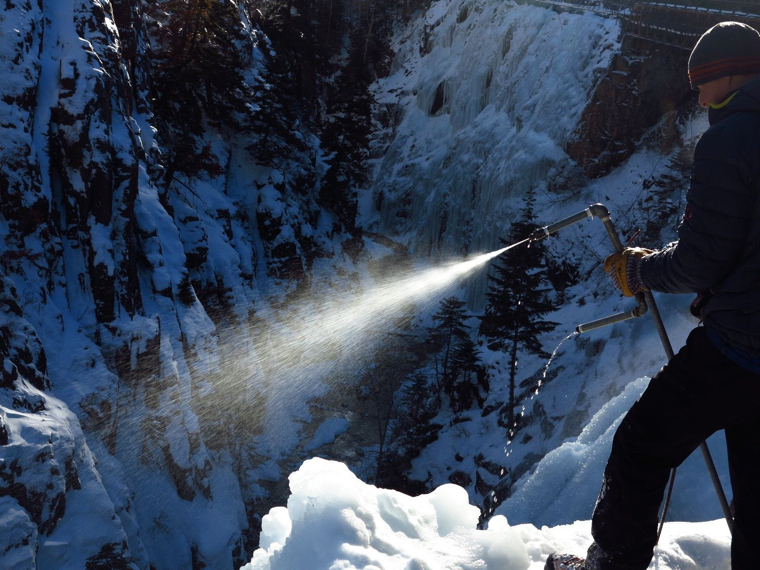
Making Ice
pc: Dan Chehayl
With a burgeoning world-class venue to promote, the Ouray Ice Festival soon was born. The first-ever event was held in January 1996, nurtured under the guidance of Jeff Lowe. Since its beginnings, the Ice Fest has been described as a sort of “gathering of the tribe” of dirtbag climbers, ice climbing celebrities and neophytes.
In those early years, there wasn’t an official competition, but the festival did feature a number of climbers “all handpicked by Jeff,” who showed off their moves in an ice climbing exhibition on routes set and demoed by Lowe.
“There were a lot of good Swiss climbers, and they mopped the table with everybody,” Whitt recalled.
The formation of Ouray Ice Park Inc. (OIPI) followed closely on the heels of the inaugural Ice Festival, with the formal organization coming into being in January 1997 to guide and govern the growth and management of the Ice Park.
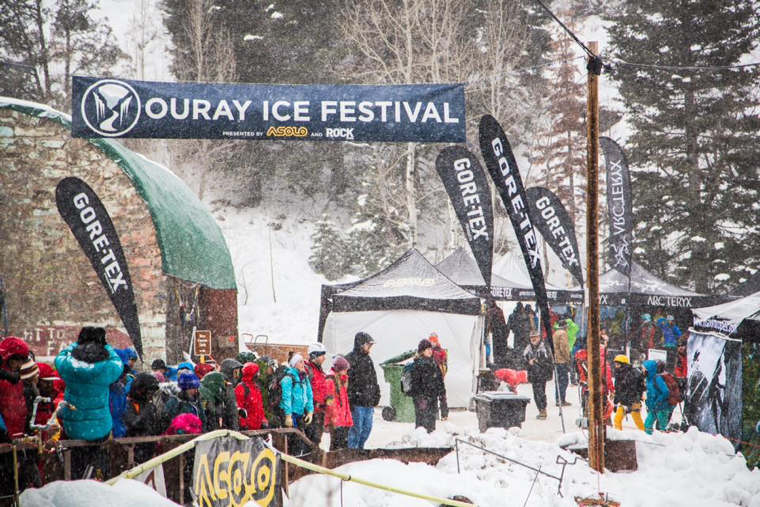
Ouray Ice Festival
pc: Dan Chehayl
In 2001 Lowe sold the Ouray Ice Festival to OIPI. The Festival’s shift to local ownership represented a vital first step in its evolution into the internationally recognized event it is known as today. A festival that was once visited by only a handful of American ice climbers and a dozen or less sponsors now boasts an internationally touted competitive field, upwards of 40 sponsors and many opportunities for non-competitive climbers of all ages and skill levels to be involved in the festivities through its adult and children’s climbing clinics.
The Ouray Ice Park and the Ouray Ice Festival enjoy a symbiotic relationship. The park provides a picture-perfect ice-climbing venue, while the festival serves as the Park’s primary revenue source (accounting for over 70 percent of the Park’s annual budget).
Almost a quarter-century after it was founded, Ouray Ice Park still upholds the creative, can-do, grassroots spirit of its founders, providing a mind-boggling variety of accessible, open and free ice climbing terrain, all just a few minutes’ walk from downtown Ouray.
Coming of Age
Over the years, the Ice Park has grown alongside its reputation. Today the park spans more than a mile of the Uncompahgre Gorge and offers more than three vertical miles of terrain in about 200 identified routes equipped with dozens of fixed anchors and access points. Its sophisticated, one-of-a-kind, gravity-fed plumbing system has evolved considerably, too, since those early days of dribbling hoses that had to be thawed in a hot tub every time they froze. Using more than 7,500 feet of pipe and 235 spray nozzles, over 270,000 gallons of highly pressurized spring water are ideally sprayed and dribbled on the canyon walls on a typical winter’s night.
Thanks to the Ouray Ice Park, the community that spawned it has also been transformed. Most motels in Ouray now stay open year-round. Shops and restaurants have followed suit, many staying open to serve the ice-climbing crowd through the winter months. Local business owners warmly welcome the estimated 7,000-8,000 ice climbers who flock to the area each winter with full wallets, big appetites and high spirits, spending a whopping million dollars a month in Ouray throughout the winter season.
For the City of Ouray, that has translated into gains greater than 140% in lodging taxes and 82% in sales taxes for the winter months of December, January, February and March since the Ice Park was created in 1994.
OIPI, meanwhile, has grown alongside the Ice Park into a complex organization that is important to a number of constituencies, including the City of Ouray, professional guides, local businesses, educational and noncommercial groups, outdoor industry sponsors and the growing climbing community.
Its all-volunteer board and handful of paid employees face an endless balancing act of structuring an organization that can meet the financial demands of keeping the Ice Park sustainable, and managing one of the world’s most unique outdoor adventure venues.
Despite the high cost of its maintenance, the Park remains free and open for public use. It has become one of the premier ice climbing venues on the planet.
On Thin Ice
All this might sound like an incredible success story – and it is – but the Ouray Ice Park has also had its share of challenges in recent years.
A beetle epidemic has killed off many of the white fir trees within the park. OIPI and the City of Ouray have lately grappled over water supply and management issues as the City transitions toward taking over management of the park from OIPI. Some local business owners have weighed in with their own complaints about the manner in which the Ice Park has been operated.
Overcrowding has also become a problem, with upwards of 500 climbers at the Ice Park on a typical winter weekend. Some of those climbers have become reluctant to follow park rules that limit each party to hanging just two ropes up at a time, for a three-hour period, before moving on to a new climbing area, instead staking out areas of the park where they will climb all day – very much a way to kill the stoke.
These are all issues that can be resolved. But the toughest long term problem the Ouray Ice Park now faces is climate change, and Mother Nature’s increasing reluctance to provide enough long, cold nights for a new generation of ice farmers to properly do their job. Last year, warm weather and scarce water forced the Ice Park to shut down six weeks earlier than normal.
It was a crushing, demoralizing blow, both to the ice climbing community and the local businesses that depend upon the Park.
One degree’s difference is all it takes to turn water into ice. And vice versa.
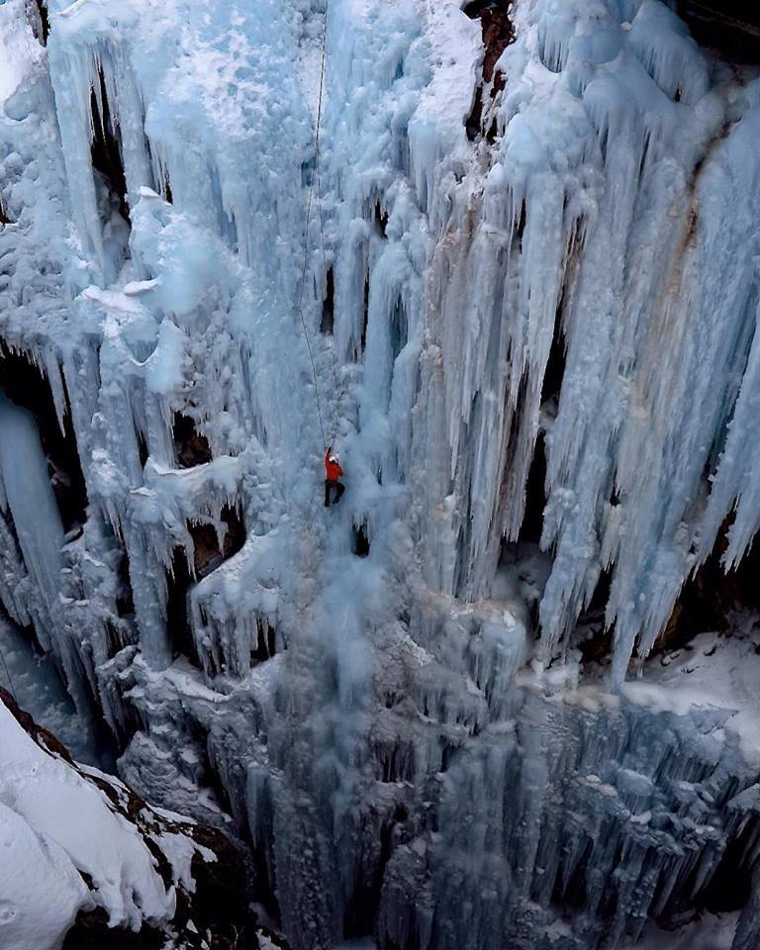
Big Ice
pc: Dan Chehayl
But the resilient Ouray Ice Park tribe refuses to be daunted, and continues looking for innovative solutions to attack this latest challenge. Perhaps developing new water sources to augment the municipal water supply will allow them to build a thicker, more resilient base of ice, that will hold up better against warming temps. Perhaps more tweaks to the Ice Park’s plumbing system will allow them to farm that ice in even more effective and efficient and smarter and safer ways. There is hope. Even on thin ice.
After all, climbing puts us in awesomely inhospitable and impossible places, but with the right tools and encouragement, we learn that we can claw our way out of just about anything.
– END –
For more information on the Ouray Ice Festival click here.

